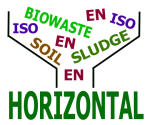HYGIENIC Parameters
Standards on hygienic parameters with performance characteristics. The work on the hygienic parameters was carried out as HORIZONTAL-HYG under contract SSPI-CT-2004-513660 with DG RTD
BT/TF 151 WI | Topic | Title | Final draft standard | Updated report | Validation data |
Validation | Validation Study report E. coli and Salmonella spp. Inter-laboratory study | ||||
CSS99050-1 | EColi | Soils, sludges and treated bio-wastes — Detection and enumeration of Escherichia coli – Part 1: Membrane filtration method for |
| ||
CSS99050-2 | EColi | Soils, sludges and treated bio-wastes — Detection and enumeration of Escherichia coli — Part 2: Miniaturised method (Most Probable Number) by inoculation in liquid medium |
|
| |
CSS99050-3 | EColi | Soils, sludges and treated bio-wastes — Detection and enumeration of Escherichia coli — Part 3: Macromethod (Most Probable Number) in liquid medium |
| ||
CSS99051-1 | Salmonella | Soils, sludges and treated bio-wastes — Detection and enumeration of Salmonella spp. – Part 1 : Membrane filtration method for quantitative resuscitation of sub-lethally stressed bacteria (to confirm efficacy of log reduction treatment procedures) |
| ||
CSS99051-2 | Salmonella | Soils, sludges and treated bio-wastes — Detection and enumeration of Salmonella spp. – Part 2 : Liquid enrichment method in Selenite |
|
| |
CSS99051-3 | Salmonella | Soils, sludges and treated bio-wastes — Detection and enumeration of Salmonella spp. — Part 3: Presence/absence method by liquid enrichment in peptone-novobiocin medium followed by Rappaport Vassiliadis medium | |||
Part 1 | Clostridium | Soils, sludges and treated bio-wastes — Isolation and enumeration of Clostridium perfringens – Part 1: Membrane filtration method onto selective agar. | |||
Part 2 | Clostridium | Soils, sludges and treated bio-wastes — Detection of Clostridium perfringens – Part 2: Macromethod (Most Probable Number) by inoculation into selective liquid medium |
|
| |
Part 1 | Enterococci | Soils, sludges and treated bio-wastes — Isolation and enumeration of intestinal enterococci – Part 1: Membrane filtration method onto selective agar |
| ||
Part 2 | Enterococci | Soils, sludges and treated bio-wastes — Detection and enumeration of intestinal enterococci – Part 2: Miniaturised method (Most Probable Number) by inoculation in liquid medium | |||
Part 1 | Helminth Ova | Soils, sludges and treated biowastes – Detection and enumeration of viable helminth ova - Flotation method on calcium nitrate solution, specific gravity 1.35 | |||
Part 2 | Helminth Ova | Soils, sludges and treated biowastes – Detection and enumeration of viable helminth ova - Flotation method on Natrium nitrate NaNO3 solution, specific gravity 1.35 | |||
Part 3 | Helminth Ova | Soils, sludges and treated biowastes – Detection and enumeration of viable helminth ova - Flotation method on Zinc sulphate ZnSO4 solution, specific gravity 1.35 | |||
Bacteriophages | Soils, sludges and treated bio-wastes — Extraction of bacteriophages. | ||||
Plantpathogens | Soil, sludge and treated biowaste – Literature review on | ||||
D3.4 | Process validation | Methods for the validation of biotechnological, thermal and chemical processes for the treatment of animal by-products, sewage sludge and biowastes in order to determine the hygienic safety of the resulting fertilizers or comparable products by exposition of test organisms or test viruses - Part 1 : Validation with vegetative bacteria | |||
D3.4 | Process validation | Methods for the validation of biotechnological, thermal and chemical processes for the treatment of animal by-products, sewage sludge and biowastes in order to determine the hygienic safety of the resulting fertilizers or comparable products by exposition of test organisms or test viruses - Part 2 : Validation with test viruses | |||
D3.4 | Process validation | Methods for the validation of biotechnological, thermal and chemical processes for the treatment of animal by-products, sewage sludge and biowastes in order to determine the hygienic safety of the resulting fertilizers or comparable products by exposition of test organisms or test viruses - Part 3 : Validation with parasites eggs | |||
D3.4 | Process validation | Methods for the validation of biotechnological, thermal and chemical processes for the treatment of animal by-products, sewage sludge and biowastes in order to determine the hygienic safety of the resulting fertilizers or comparable products by determination of the count of selected endogenous organisms in the substrate before and after processing and calculation of the reduction rate (Input-Output-Analysis) |
|
# Not validated
